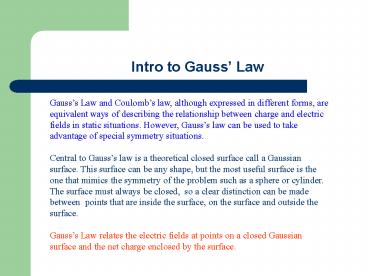Intro to Gauss Law - PowerPoint PPT Presentation
1 / 8
Title:
Intro to Gauss Law
Description:
Applying Gauss' law we could calculate the amount of charge enclosed. However, this calculation requires knowledge of the flux of the electric field ... – PowerPoint PPT presentation
Number of Views:176
Avg rating:3.0/5.0
Title: Intro to Gauss Law
1
Intro to Gauss Law
Gausss Law and Coulombs law, although expressed
in different forms, are equivalent ways of
describing the relationship between charge and
electric fields in static situations. However,
Gausss law can be used to take advantage of
special symmetry situations. Central to Gausss
law is a theoretical closed surface call a
Gaussian surface. This surface can be any shape,
but the most useful surface is the one that
mimics the symmetry of the problem such as a
sphere or cylinder. The surface must always be
closed, so a clear distinction can be made
between points that are inside the surface, on
the surface and outside the surface. Gausss Law
relates the electric fields at points on a closed
Gaussian surface and the net charge enclosed by
the surface.
2
Intro to Gauss Law
If the electric field at all points on the
spherical surface has the same magnitude and
point radially outward, you could safely assume
that some net positive charge is enclosed.
Applying Gauss law we could calculate the amount
of charge enclosed. However, this calculation
requires knowledge of the flux of the electric
field through the surface. What is flux ???
3
Flux
- A uniform airstream of velocity v is
perpendicular to the plane of the loop of area A - ? represents the volume flow rate (volume
per unit time) at which air flows through the
loop. In this case, ? vA - The air stream direction has been rotated by an
angle ? - The component of v perpendicular to the
plane of the loop is v cos?, where ? is the angle
between v and normal to the plane. In this case,
? v cos? A - The area vector A is perpendicular to the plane
of the loop and makes an angle ? with v. A is
defined as vector whose magnitude is equal to the
area and direction - is normal to the plane of the area.
- ?
v cos? A v A - (d) The velocity field intercepted by the area
of the loop. We can assign a velocity vector to
each point in the area therefore ? is the flux of
the velocity field through the loop. ? product
of an area and the field across that area.
4
Flux of an Electric Field
- An arbitrary Gaussian surface immersed in an
electric field. The surface is divided into small
squares of area ?A each represented by an area
vector ?A. The direction of each ?A is
perpendicular to the Gaussian surface away from
the interior. - The vectors E and ?A make an angle ? with each
other. The figure shows an enlarged view of three
squares (1,2 and 3) on the surface and show the
angle ?. - A finite element definition of the flux of the
electric field for the Gaussian surface can be
written as - ? E ?A
- The equation tells us to look at each individual
square on the surface to evaluate each dot
product, as shown by the enlarged view of the
three select squares. Some contributions will
have positive, negative, small and large values.
5
Electric Field flux
If we allow the area vectors to become smaller
and approach a differential limit, the above
equation becomes
The circle on the integral sign indicates that
the integration is to be taken over over the
closed surface. Recall that the magnitude of E
is proportional to the number of electric field
lines per unit area. Therefore the scalar product
is proportional to EdA is proprotional to the
number of electric field lines passing through
area dA. Since the integration is carried out
over a closed Gaussian surface, The electric
flux ? through a Gaussian surface is proportional
to the net number of electric field lines passing
through that surface.
6
Gauss Law
Gauss law relates the net flux ? of an electric
field through a closed surface to the net charge
qenc by that surface.
(Gauss Law)
or
7
Gauss Law
Two point charges, equal in magnitude but
opposite in sign and the field lines represent
their net electric field. Four Gaussian surfaces
are shown in cross-section. Surface S1 encloses
the positive charge. Surface S2 encloses the
negative charge. Surface S3 encloses no charge.
Surface S4 encloses both charges, therefore
zero net charge.
8
Gauss Law and Coulomb law
The angle ? between E and dA is zero at any
point on the surface, we can re-write Gauss Law
as
E has the has same value at all points on the
surface
E is can be moved out
Integral is the sum of surface area
A spherical Gaussian surface centered on a point
charge q
Coulombs Law

